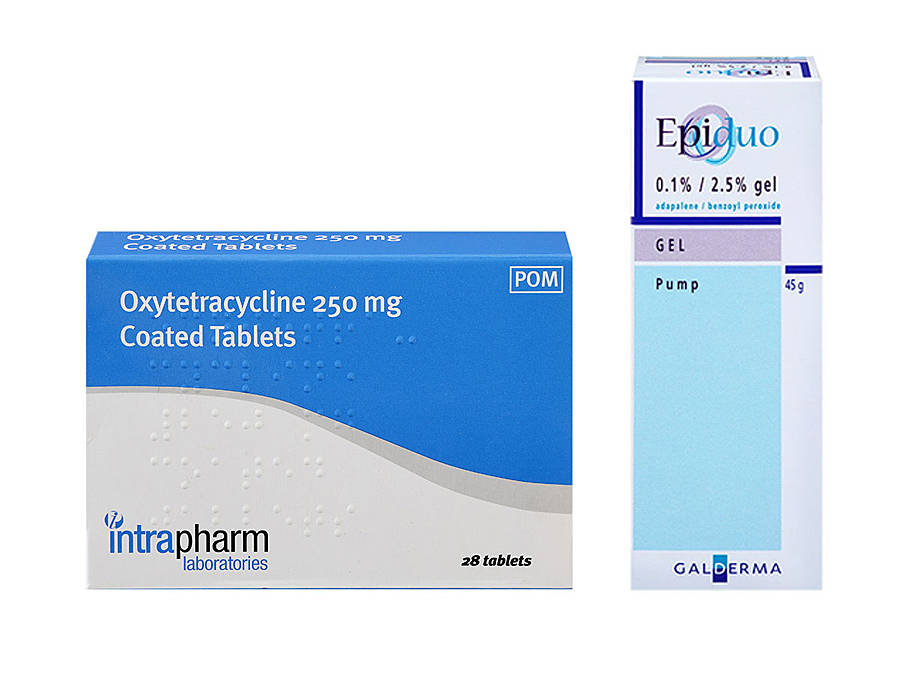Oxytetracycline and Epiduo
Order Oxytetracycline and Epiduo Online


Oxytetracycline is an antibiotic treatment for acne. It reduces the inflammation on your skin and fights the bacteria which cause spots and skin lesions. Epiduo is a topical gel that can improve acne symptoms.
You can order acne treatment without having to see your GP - our online doctors can diagnose acne and prescribe a medication. To place your order, fill in our brief questionnaire and provide a photograph of your skin condition. Our doctor will review your order and approve appropriate treatment before we post your medication.
Prescription and delivery are included.
Please note: where a generic product has been ordered we may use a range of manufacturers to provide you with your medication, in order to maintain our service levels.



About Oxytetracycline
What is oxytetracycline?
Oxytetracycline belongs to a group of antibiotics called the tetracyclines. It's used to treat a wide range of bacterial infections, as well as acne.
How do oxytetracycline and Epiduo work?
The oxytetracycline antibiotic targets the bacteria which inflame the skin when you have acne. The treatment works since the antibiotic kills the bacteria which contribute to your acne (Propionebacterium acnes). These bacteria feed on the sebum produced by glands in the skin, and produce waste products that inflame the sebaceous glands, producing whiteheads and itchy, red skin. By using an antibiotic treatment to control the growth of the bacterial population which cause acne, your acne can be managed.
Epiduo contains benzoyl peroxide, which kills bacteria around your acne symptoms, and adapalene, which works like vitamin A to help your skin function.
Should I stop treatment when my acne clears up?
We recommend that you check with your doctor before stopping your treatment, even if your skin has cleared up. Treatment should usually be continued for 8 to 12 weeks to see the best effect.
Can I do anything else to clear my acne?
There are a lot of common myths about what causes acne.
A bad and unbalanced diet is, of course, bad for your general health. However, no clinical studies have shown a direct link between food and acne.
A lot of people think that stress can bring on acne. But this is not true; it can only make your acne worse if you already suffer from it.
The best thing to do is to follow your treatment plan and remember to take your medication at the correct time.
Can I still wear makeup?
Yes, you can apply makeup while suffering from acne and while taking acne treatment. However, greasy makeup may be contributing to inflaming your skin and making your acne worse. So it’s a good idea to avoid greasy makeup while you have acne.
Can I still use contraceptives while I'm taking this treatment?
You can still take oral contraceptives while on this treatment. The latest recommendations are that most antibiotics, including oxytetracycline, do not stop your oral contraceptive pill from working. But if you get any side effects of diarrhoea or vomiting with the antibiotics, you should use extra precautions as they can affect the pill.
Warnings
You must not take oxytetracycline if you:
- are allergic to any of the ingredients in the tablets
- have had long term kidney or liver problems
- have systemic lupus erythematosus (rashes on the face, hair loss, fever and joint pain)
- are under 12 years old
- are pregnant or breastfeeding
You must inform your doctor if you suffer from myasthenia gravis (muscle weakness, difficulty chewing and swallowing and slurred speech) or if you have reduced kidney or liver function.
You must inform your doctor if you are taking any of the following medicines:
- Penicillins
- Vitamin A
- Retinoids (acitretin, isotretinoin and tretinoin to treat acne)
- Anticoagulants (i.e. warfarin)
- Diuretics (i.e. furosemide)
- Kaolin-pectin and bismuth subsalicylate (for the treatment of diarrhoea)
- Medicines to treat diabetes (i.e. insulin, glibenclamide or gliclazide)
- Methoxyflurane (anaesthetic; tell your doctor if you are due to have an operation)
- Antacids or other preparations containing aluminium, calcium, iron, magnesium, bismuth or zinc salts ( you should not take these at the same time as you take your oxytetracycline)
How should I take oxytetracycline and Epiduo?
Most importantly, you need to take oxytetracycline as your doctor advises. You should take tablets one hour before or two hours after a meal. You need to swallow the tablet whole with a full glass of water. You should not take the tablets just before you go to bed.
To treat acne the recommended dose of oxytetracycline is two tablets of 250mg, twice a day. It can take up to 8 weeks to see the full benefits of the medication so we recommend that you continue for at least this time. Usually treatment will be reviewed at 3 months to see if it should be stopped or continued.
If you overdose, seek medical assistance immediately.
If you forget to take a tablet, take it as soon as you remember. If this is near the time or your next due dosage, do not double dose, but skip the missed dose and continue as normal. You should try not to take oxytetracycline with food or milk, as they can make the treatment less effective.
To take Epiduo, apply a thin layer of gel to your symptoms once a day.
Ingredients
The active substance is oxytetracycline dehydrate (250mg or 500mg depending on the dosage of the tablet). The other ingredients in the tablet are magnesium stearate, maize starch, hydroxypropyl cellulose (E463), colloidal silica, sodium lauryl sulphate, propylene glycol, sunset yellow (E110), quinoline yellow (E104), titanium dioxide (E171), methylhydroxypropyl cellulose (E464) and purified talc (E553).
Epiduo’s active ingredients are adapalene and benzoyl peroxide. Epiduo also contains disodium edetate, docusate sodium, glycerol, poloxamer, propylene glycol (E1520), simulgel 600PHA, and purified water.
Do I need a prescription?
Yes. You can get this from your doctor or online at ZAVA.
What do the tablets look like?
The tablets are yellow, circular and biconvex.
Oxytetracycline and Epiduo side effects
If you get any of the following side effects, seek medical assistance:
- Allergic reaction (swollen lips and face, itchy skin, difficulty breathing)
- Symptoms of raised pressure in the skull (headache, visual problems, blurred vision, blind spots, double vision)
- High sensitivity to sunlight
You should tell your doctor if you experience any of the following oxytetracycline side effects:
- Vomiting
- Diarrhoea
- Discolouration of teeth
- Difficulty swallowing
- Swelling of the gullet
- Loss of appetite
- Redness of the skin, flaky skin
- Thrush or irritation round anus and genitals
Common Epiduo side effects include:
- a skin rash on the areas that you’ve used Epiduo
- redness, irritation, or burning sensation where you’ve used Epiduo
- dry or scaly skin
If you experience any of these side effects or any others, talk to your doctor.

Dr Kathryn Basford is an IMC and GMC registered GP who works with our Irish team here at ZAVA. She graduated from the University of Manchester and completed her GP training at Whipps Cross Hospital in London.
Meet our doctorsLast reviewed: 27 Apr 2019
